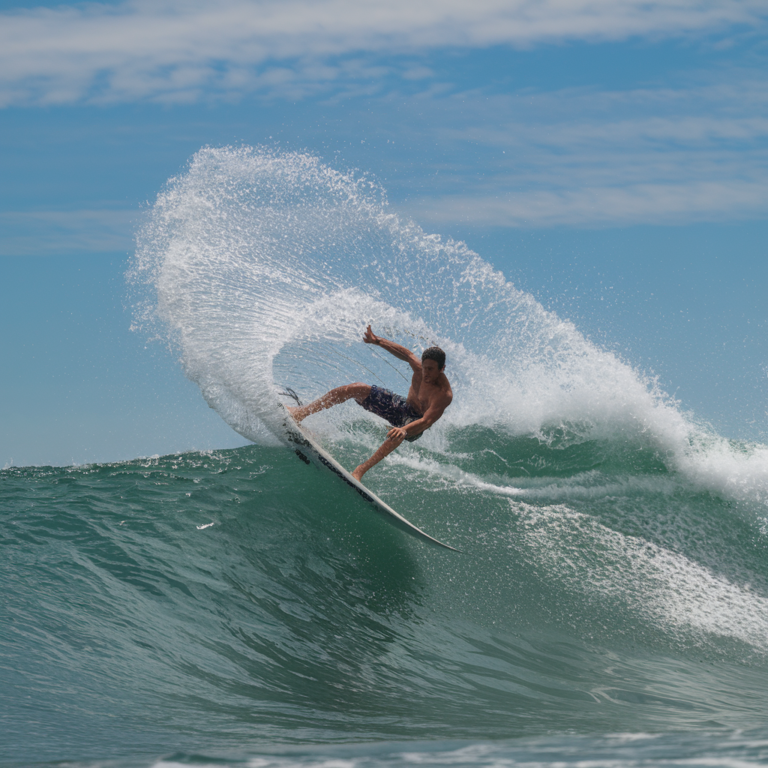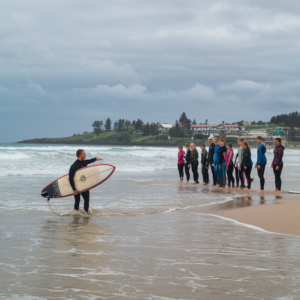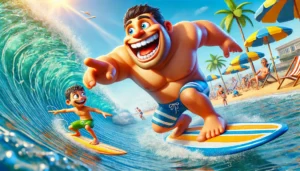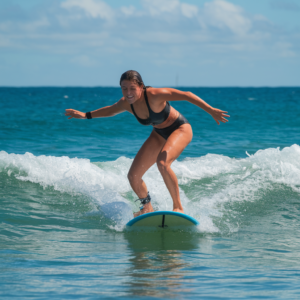When you pick up a new surfboard, the first thing you notice is that the surface is slippery. Surfers use two main methods to help them stick to their surfboards: applying wax and installing traction pads, also called stomp pads, or grips.
Every time I buy a new surfboard I ask myself. Do I need a traction pad?
Here are my thoughts on some pros and cons related to this question.
In general, surfboard traction pads are beneficial on short boards (under 7 feet in length), or boards where the foot placement is important. When you are popping up, executing tricks or moving your feet, traction pads can help you quickly locate the ideal foot positioning.
Now, it’s important to mention that using a traction pad on your surfboard is a personal choice.
I hope to provide you with some helpful Pros and Cons in case you are wrestling with the decision, lets go!
Surfboard Traction Pads Styles
Traction pads came on-stream and gained popularity in the 1980’s. Up until that point, wax was the primary option for establishing traction on a surfboard.
As of today, traction pads fall into a couple of different groups:
- Tail Pads (the most common) – Installed on the tail of your surfboard to provide traction for your back foot.
- Deck Pads (less common) – Installed on the deck of your surfboard to provide traction for your front foot.
1. Endless Traction Pad Options
The last time I purchased a traction pad, I went to three different surf shops and probably looked at 75 different traction pads. Some people might say that there are too many choices.
Traction pads come in a variety of different colours, sizes, pieces, styles and materials. Let me run through a few of the things you may want to think about when choosing your next traction pad :
- Materials – Traction pads are generally made of a grippy, water resistant foam that is formed into a grooved or patterned surface. Recently, many new environmentally friendly materials have hit the market, including eco-friendly foam, algae foam, cork and recycled cork.
- Styles – Deck pads generally sit flat on your board so that you can lie on them comfortably. Tail pads come in a few different styles including, flat, with or without an arch bar and varying degrees of tail kick (like the tail of a skateboard).
- Pieces – Traction pads come in a single piece or multiple pieces. More pieces = more options! More pieces will give you greater flexibility to decide on different placements for your feet.
- Sizes – Tail pads and deck pads come in different sizes which relate to how much area you want covered on your surfboard, so either bring your board to the shop or measure it ahead of time.
- Colour – Colour is very important! Do you want it to stand out? Blend in? Match the colour of your surfboard? I always pick a colour that makes me happy, the last time I picked orange!
2. Foot placement Guide
Whether we are talking about a tail pad for your back foot or a deck pad for your front foot, traction pads will help you locate your foot placement.
On short boards (surfboards that are less than 7 feet long), there is less margin for error with foot placement. When a surfer pops up and gets to their feet, they can move their foot and “feel” for the spot on the traction pad with the correct positioning based on practice and familiarity.
In addition, many surfers don’t locate their back foot over the fins which helps to turn the surfboard more easily. A tail pad provides a physical reminder where the back foot should be placed for optimal performance.
3. Traction Pads Can’t Be Moved Easily
Traction pads are grippy on top so your feet don’t move and sticky on the bottom so the pad doesn’t move! Once traction pads are installed on your surfboard correctly, they don’t move.
For boards over 7 feet long, foot placement is less important and surfers may want to move up and down the length of the board, walking or shuffling their feet without a traction pad in the way.
Many surfers, including a lot of my friends, don’t like a big piece of immovable foam stuck to the top of their surfboard and prefer the flexibility that comes with a relatively uniform coating of wax on their surfboard.
4. Ease of Installation
Traction pads are easy to install. It’s kind of like putting big, thick stickers on your surfboard.
The most important part is having a clean surface. Make sure there is no wax, dirt, or sand.
And the tricky part is to align the pad on your surfboard. Although, it won’t make any difference with your surfing, it will look weird! We all know looks are important, right? 🙂
Installing a traction pad process
There are many different tips for installing a tail pad, but the following video by 11 time World Surfing Champion, Kelly Slater teaches you the perfect surfboard traction pad placement.
4. Surfboard Traction Pads help You Save Money on Wax
When you install a traction pad on your surfboard, you won’t need to put wax on for a long time. In the case of a tail pad, you will no longer have to apply and re-apply wax to that section of your surfboard.
5. Wax Or Tail Pad?
When you install a traction pad on your surfboard, you won’t need to put wax on for a long time. In the case of a tail pad, you will no longer have to apply and re-apply wax to that section of your surfboard.
Obviously, you will still need to wax the exposed areas of the surfboard that require grip but you will be saving money on wax over the long term and your wax budget will be cut in half.
6. Removal And Replacement
Traction pads aren’t that difficult to remove. You may think a traction pad is a long-term commitment but if you don’t like the style or you want to go back to wax, just take it off.
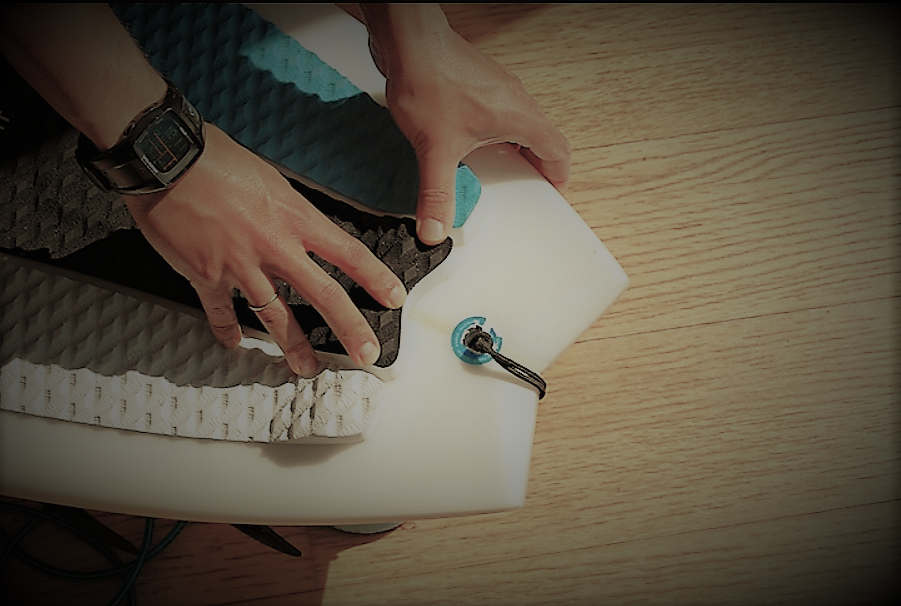
Traction Pad Removal Process:
- Start at the corner and peel up the pad with a razor blade.
- Remove any excess bits.
- Use acetone (nail polish remover works too) to get the left over sticky bits off
7. Surfboard Protection
As I mentioned previously, traction pads are like having a big, padded sticker on your surfboard.
They range in thickness from about 2mm-10mm and provide extra protection from feet, heels, knees and anything else that can create dents and compression on the deck of your surfboards.
To learn about ways to make your surfboard last longer, read this:
10 Awesome Tips to Make Your Surfboards Last Longer
8. Duck Diving is easier
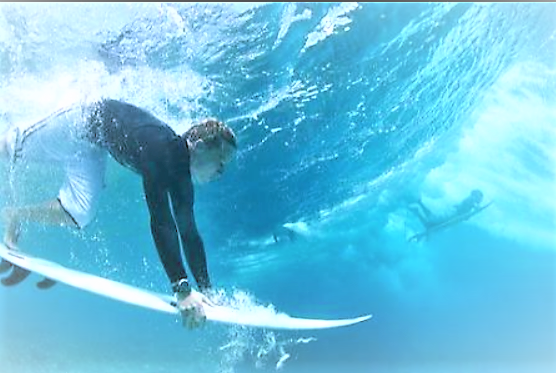
Duck diving is made easier with a traction pad. You can use the tail pad to get leverage by putting your knee or your foot on the pad and pushing down to submerge your board parallel to the bottom. To watch this duck diving technique using the tail pad, check out this video.
9. Optional on longer boards
For boards over 7 feet long, foot placement is less important and surfers may want to move up and down the length of the board, walking or shuffling their feet without a traction pad in the way.
If you are considering sticking a traction pad to a longer, soft topped surfboard, there may be issues with adhesiveness between the traction pad and the foam deck of the surfboard.
10. Surfboard Traction Pads Are Cheap
Traction pads are relatively inexpensive when you factor in the benefits, including, saving money on wax, protecting your surfboard and helping with the correct foot positioning.
Traction pads start around $35 and go up from there. You can buy tail pads & deck pads individually or a combo package that will include enough traction pads to fully cover the deck of your surfboard.
In conclusion
It doesn’t matter if you are a beginner or an expert surfer, the decision to install a traction pad comes down to your own personal preferences. I fall somewhere in the middle, I like traction pads on some of my boards and for others I prefer just wax.
For more info on traction pads, read this article:
Surfboard Traction Pads: Why They Make Surfing Better
FAQs
What is the purpose of a surfboard traction pad?
A surfboard traction pad, also called a stomp pad or grip, is there to help your back foot stay firmly planted on the board. It gives you better control, especially when you’re carving turns or making quick maneuvers.
Plus, the pad’s texture and raised kicktail offer a feel that helps guide your foot placement naturally. You’re not constantly worrying about where to position your foot, allowing you to focus more on riding the waves and improving your balance.
Do I need a traction pad if I use surfboard wax?
You don’t have to use a traction pad if you’re already waxing your board, but they do serve similar purposes.
The most common setup is to have a traction pad on the tail for the back foot, and wax towards the middle of the surfboard for the front foot.
Wax provides grip all over the board, which is great, but it needs to be reapplied regularly, and can sometimes get slippery, especially during long sessions or in warmer water.
A traction pad, on the other hand, gives you a long-lasting, reliable grip specifically for your back foot, where you need it most for control and power when turning.
How long does a traction pad last?
A good-quality traction pad can last for years, but it really depends on how often you surf and how well you take care of your board. Most traction pads will last for the lifetime of the surfboard.
With normal use, even in salty water and sun, a pad can hold up for quite a while.
However, if you’re out in the water every day or leave your board in direct sunlight for long periods, the pad’s adhesive might start to break down faster.
The key to making it last is rinsing your board with fresh water after each session and storing it in a cool, shaded place.
Are there different types of traction pads?
Yes, there are definitely different types of traction pads.
Some pads come as a single piece, while others are multi-piece, which lets you adjust the spacing to fit your board and surfing style.
They also have different features, like arch bars in the middle for extra foot support or raised kicktails at the back to help you lock in your foot during sharp turns.
The texture of the grip varies too—some are more aggressive for added hold, while others are smoother for comfort.
Trying out different designs can help you figure out what feels best as you start gaining confidence on your board.
Ultimately, it’s a matter of personal preference.

